Open Legend by Barudak
Open Legend is available for free on https://openlegendrpg.com
Original SA post
Open Legend is available for free on https://openlegendrpg.com It contains art, tips, links to adventures, a blog, the full rules of course, and other details that this review won’t touch, so please visit the page if you’ve any interest.
The sales pitch: “ Open Legend is a tabletop roleplaying game (or RPG) in which the players take the part of mighty heroes and wicked villains in order to tell stories of epic proportion. Every game of Open Legend revolves around intrepid characters performing heroic deeds. They will fight mythic beasts, break ancient curses, solve mind-boggling puzzles, discover untold treasures, and more”
What does this all boil down to? Open Legend thinks of itself as a middle ground between extremely crunchy murder-hobo games and fluffier more story-focused-but-still-kind-of-murder-hobo games, trying to keep the best of both. Is there a term for this? If not I'm calling it a Second Wave Heartbreaker tm.
The core rulebook proper is split into 8 parts, and we'll be covering each in a post. The rulebook, as a series of webpages, is almost devoid of art so I'll be liberally copying from their page and crediting artists as Open Legend's publisher Seventh Sphere credited them.
Introduction:.
The book begins with two, thankfully, very short bits of purely tonal fluff. In the first treasure seekers loot a tomb and then prepare to fight monsters in the dark. In the second an elf and a dwarf bicker with each other while a wizard handles the fight. There is nothing particularly notable here, they’re just sort of plopped in front of you and then forgotten without a second mention so I'll do the same.
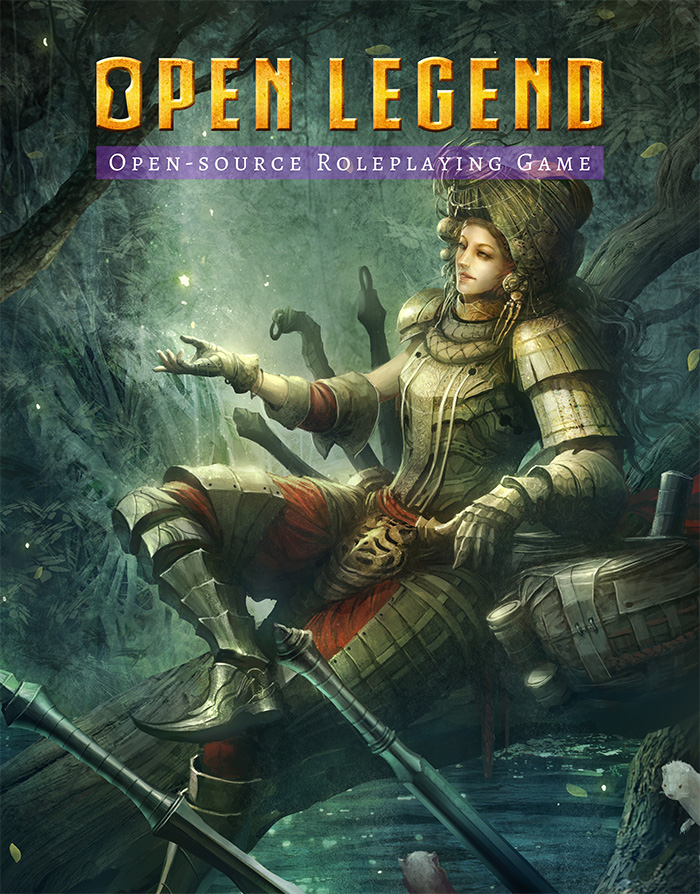
behold the book cover for a physical book and pdf that don't exist - Artwork by: Saryth
The book now starts in earnest with three similar but different introductions, presumably each for different levels of reader knowledge and familiarity with TTRPGs, with each being overlapping but not quite the same. The first, “Welcome to Open Legend” is the general introduction to TTRPGs featuring the sales pitch copied above, an intro to GM and PC role, and a claim that the game can run games from “Lord of the Rings” to “Monty Python and the Holy Grail” which, unless I forgot the derived stat calculation scene, it may not handle the latter very well. The second, “Why Open Legend” is an elevator pitch on why you should pick Open Legend, which is odd since you’re already into the rulebook at this point. It consists of a short 3-point bullet point list: its open source, dice can explode when you roll them so there is lots of rolling and random swings of chance, and that you don’t have specific classes or mandatory race or class combinations*.
The third of these, “What Defines Open Legend”, is the in-depth summary of the sort of game you can expect to run in Open Legend. It covers the objectives of the game, what it plans to cover, what makes it unique, and what they hope you get out of it. Oddly, the unique features it mentions in this section on what's great about Open Legend don’t overlap with the unique features mentioned earlier in the “Why Open Legends” section so if that was the elevator pitch apparently we’re now in a different building. The "What Defines Open Legend" section also outlines that the goal of the game is to straddle fluff and crunch and provide the DM clear rules on how to rule, which by the time we reach the end of character creation will seem less like straddling and more like "hold fluff hostage in the back of crunch's getaway car".
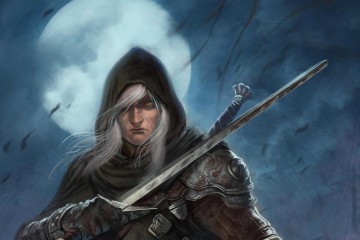
the above is Sir Not Appearing in the Core Rules - Artwork by: Dleoblack
After finishing this section the games introduction section concludes by introducing and defining its rolling resolution mechanic. I can’t say quite how much I appreciate this, especially since the section following this is character creation. Open Legend uses a d20 + the dice your attribute gives you versus a target number; e.g. d20 + 2d6 for a highly trained character. Pleasingly it states unequivocally matching or beating the number is a success, and failing to reach the number is either success with a twist or you fail but the plot progresses. This pleasing feeling of good failure with a twist and easy to calculate probability calculations to determine target numbers is then completely undone by introducing exploding dice. If you hit the maximum on any die you roll you keep this value and can reroll it, adding the second total to the first and going possibly to infinity. Further, I can’t figure out why a d20 is part of the formula other than tradition as it makes rolling for success oddly swingy and requiring all target numbers to be inflated by 10.
Before we get to the next part of this F&F please keep this in your mind as it is a direct quote from the creators "You spend your day job worrying about bookkeeping and policies. We don’t want the gaming table to feel like that, and we designed Open Legend to focus on the fun rather than the homework."
*This is the free square on your heartbreaker bingo cards. No prizes will be awarded in this bingo.
Up Next: Create Any Character You Can Imagine! (If your eyes don’t just roll off the page)
Character Creation
Original SA post
Open Legend is available for free on https://openlegendrpg.com It contains art, tips, links to adventures, a blog, the full rules of course, and other details that this review won’t touch, so please visit the page if you’ve any interest.
Character Creation:.
We’ll kick off this section by copying the following quote again because please, keep it forever in mind as we move forward as this occurs no less than a single sub-section ago. “You spend your day job worrying about bookkeeping and policies. We don’t want the gaming table to feel like that, and we designed Open Legend to focus on the fun rather than the homework.” They’ll make better on this promise later, I swear, but sadly now is not that time.
This section begins with a request to think of our favorite fantasy movies, books, or games; we’re not told anything about comic books, audio dramas, and oral traditions so get bent Homer. We’re then asked to pick what characters we identified with and who inspired us. This character archetype we identify with is then what we’re supposed to then keep in mind as we create our character using their free-form classes system. Before we get into the full rules for character creation, I can’t promise I’ll have time, but I will take at least one suggestion and give it the old college try with this game.
After that character type free-association session, we’re brought into an explanation of attributes. The wagon wheels of fluff now fly off due to a crunch-quake because there are nineteen attributes to track. Attributes are divided into physical, mental, social, and supernatural and each attribute is scored on a system of 0-9 with 0 being untrained and 9 being “superhuman.” Based on my reading of the rules, 0 is no familiarity whatsoever and 9 is approximately Captain America caliber. The game also for some reason calls out that the average commoner has a 1-3 score in multiple stats, which mechanically means we’ll find out that some starting characters are basically a dust-farmer’s richer, dirt-farming cousin in terms of starting stats.
Attributes are as follows, but more fully described in the rulebook and charted better:
Physical Attributes: Agility, Fortitude, Might
Mental Attributes: Learning, Logic, Perception, Will
Social Attributes: Deception, Persuasion, Presence
Supernatural Attributes: Abjuration, Alteration, Creation, Divination, Enchantment, Energy, Entropy, Illusion, Movement
After that rousing introduction to each attribute, we’re told how we can build characters’ attribute distributions. We can either use pre-fab arrays, suggested distributions for pre-fab class concepts, or a point buy system which the game provides the points->attribute conversion chart. At level one, the highest any attribute is allowed to go is 5, and we can split our points across any number of the attributes. To my annoyance, however, the game does state you don’t need to spend all your points at character creation and can hold onto them for later which is just another layer of option paralysis to chuck onto players.
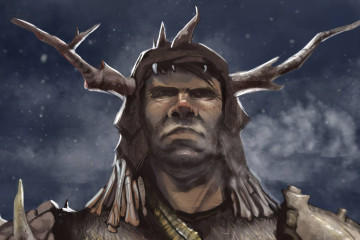
that face you make when you have 19 attributes – Artwork by: Vorpal Pen
Now that we’ve got our attribute scores, the game gets us to calculate our first of the derived stats in this game. Attribute scores correlate to a certain amounts of bonus dice players can add to their rolls using that attribute. A score of 0 gets no bonus, 1 gets 1d4, 2 gets 1d6, 3 gets 1d8, 4 gets 1d10, and 5 gets 2d6. For those of you who remember the exploding dice rolls from earlier might realize that 2d6 is not just 1.5 average higher results higher compared to the 1d10 but also massively more likely to have the dice explode. If someone wants to do the math, I’m happy to provide the full list of attributes + dice.
With attributes calculated and our rolls determined, we’re brought into the next set of derived stats which are your resistances to attack types. Toughness is basically any damage you’d need to tank, Evasion is anything you could dodge, and Resolve is the catch all magic resist stat. After you’ve done that, you’ll calculate your hit points which the game seems to treat as various non-damage you take until the real blow gets through.
If you weren’t having enough fun with defensive derived stats, they are further complicated since they follow different rules to calculate. Toughness is 10 + fortitude and Evasion is 10 + agility. Resolve for some reason is 10 + presence and will. Hitpoints are calculated by taking (2*(fortitude + presence + will))+10. For those playing along at home, which of the previous stats used in defense isn’t part of Hitpoints?
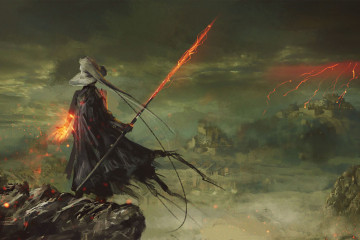
behold, my dark souls character – Artwork by: Vargasni
Remember that idea of merging crunch and fluff? And how thanks to attributes and derived stats, at best our wagon is limping onward with three wheels, hoping the worst of it is over? Hold tightly to that idea because this is where the wagon goes careening off a cliff. It’s time for feats .
At level one we’re given 6 feat points. Feats cost different amounts of these points, and like attributes we can hang onto them through level one to spend at later levels (DON’T DO THIS DESIGNERS). In addition to costing points, feats can have multiple pre-requisites or tiered pre-requisites and yes, there are feat trees but only for physical characters. Further, because we’re dumped into a raw pile of feats with extremely poor organization, there are oodles of combat mechanics we’ve not been introduced to in the feat mechanics making it even tougher to sort out what players should take.
The feat list is the same general spread of uninteresting abilities almost every feat list is so just imagine the sort of feats you would buy if you worked at corporate office of Featmart. There are some that don’t jive at all with the game’s claim towards letting you create any character you can imagine like “Attribute Substitution” where you spend 4 feat points to play mother may I with the DM to allow you to, on a situation by situation basis, substitute one physical attribute with any other non-physical attribute. This one is doubly cruel as it doesn’t work at all for physical characters who wanted to go the other way.
If instead of slogging through the feat list you’d like someone to just give you some direction, there are some pre-fab feat packages the game recommends for its classes it mentioned earlier in the attributes section. These feats are all mechanical in nature, so thankfully nobody gets a wasted fluff feat if they just want to move along.
We’re next brought to choosing our race, of which there are no descriptions other than names. Each race has a package list of basically feats they can choose from, but players may only choose one from the list for the race they chose. Since this literally the only thing race does in the game, this is a completely meaningless way to organize or even describe these benefits and picking a “race” is utterly pointless. Racial abilities of course are split into “this could possibly come up in roleplaying but subject to
Hey didn’t that intro section mention something about Banes and Boons? I wonder what those are? Boy wouldn’t it be helpful to know since like half of these feats interact with them?
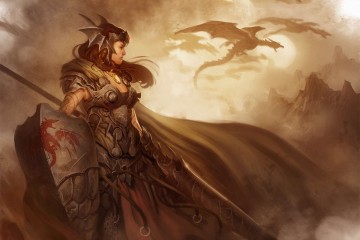
she stares wistfully at dragons, hoping one of them will explain the mechanical benefits of pants – Artwork by: Dleoblack
Are you still with us? Well, next we’re introduced to
The last character creation step we’re introduced to is describing our character. We’re asked to choose a “suitably” “heroic” “name” and given an example by the rulebook trash talking Phil the Fighter in favor of Gorion Skullcleaver*. After that we get into the actual role-playing bits of describing your character. Players need to provide two defining social traits about their character, two noticeable physical traits, and a secret that their character holds dear. Unfortunately, half the social traits the game suggests are useless (I talk in sing-song) and the secrets are meant to only be told to your GM which in my opinion is a real misstep. The game does provide decent, if cliché, secrets to kick-start players with adventure hook elements.
Then, smushed in here for no discernable reason is the section on TTRPG etiquette. Relax, don’t make it high pressure, respect the GM, don’t boss people around, some people like different parts of the game, etc. It gives a quick checklist for GMs as well to be on the watch for to make sure they’re best catering to the table, but absolutely nothing in depth or what to do to help resolve any issues.
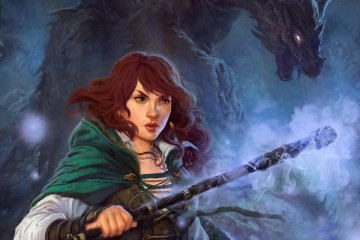
oh god, no one has described what Banes and Boons are yet. they’re right behind me aren’t they? No? They're two sections away? What?– Artwork by: Dleoblack
Finally, we’re given an overview of how characters level up. GM’s, thankfully, just arbitrarily decide when you level so no XP tracking, but the game doesn’t provide any idea of a good benchmark rate to level at. At each level up you get 9 new attribute points to spend and 3 new feat points, so if you didn’t use the point buy system to buy attributes go familiarize yourself. Annoyingly, we’re now told that 5 is the max score for an attribute all the way to level 5, with levels 6-9 having the highest score allowed being the character level. There is no indication you can’t go over level 9 but there is no mechanical support other than just more points to earn.
I do specifically want to call something out here regarding HP. You do not gain any more HP unless you raise attributes associate with the HP formula. This means the entire HP range of the game is 10-40 for the first five levels and 10-64 at level 9. There is absolutely no requirement players invest in HP producing skills so the party can end up with pretty darn different HP totals. Skimming ahead, a miss can deal a flat 5 damage if the GM chooses it and some abilities only trigger if you deal 10+ damage a turn, so unless you’ve a pretty generous gentlemen’s agreement in place with your GM you may want to be putting a lot of points into those stats.
*Do you think characters in fantasy settings don’t get call backs because their name is Phil the Fighter? “Oh he sounds so… lowlands” HR says in hushed tones as they throw his resume into the garbage can.
Up Next: Actions and Attributes! (And more things that are not Banes and Boons)
Actions and Attributes
Original SA post
Open Legend is available for free on https://openlegendrpg.com It contains art, tips, links to adventures, a blog, the full rules of course, and other details that this review won’t touch, so please visit the page if you’ve any interest.
Actions and Attributes:.
This section is all about rolling dice. More precisely it’s about when, how, what challenges are appropriate, and how rolls can be modified. This is the first section where the idea of reducing cruft rears up and it definitely is a pushback against “roll everything” and “if its not in the rules you have no recourse” style thinking.
We kick off with defining when to roll the dice. As it takes pains to make clear, you should only be rolling the dice in situations where it matters. If you’re buying something from the market or looking for something your character should know you just succeed and there is no point to rolling. This leads us into a section I quite like where the game outlines how not to handle a failed roll and examples of success with a twist and failure but story progresses. Sadly, the success with a twist is a complete jerk move but they’ll rectify that in the next section. The game then clarifies this idea of success with twist or failure still moving the story only applies to player actions, and if the GM fails a roll they just fail; no success and no twist so that players get that satisfaction of a clean win over the GM.
Next, the game gives a good set of examples of how to interpret rolls in various scenarios. It repeats that you don’t roll if there is nothing to succeed at (i.e., if there are no hidden passages don’t let them roll for hidden passages) and if they should reasonable expect to succeed at something they shouldn’t need to roll at all either. It then provides a checklist of ideas for success with a twist such as attracting unwanted attention, finding something they weren’t intending to find, making a new rival, etc. Following that, unsurprisingly, is ideas for how to have a failure still move the story along such as escalating danger, figuring out an alternate fool-proof way around the problem, or having false information that leads in a new direction. All in all, I really like this section because it gives some decent thought starters to get GMs thinking about how to accommodate different roll states.
Having introduced when to roll and how to interpret those rolls, the game introduces its challenge rating system. This is exactly as you’d expect a list of target numbers as appropriate for a given attribute score with examples. Notably, the game states that checks aren’t intended to scale, so if you set a “break wooden doors” to a 12 target score you’re to keep it the same throughout the game so players can have a sense of progression. For actions which are contested between two active parties, both roll and the highest roller wins flat out. For a contested roll, the two parties don’t have to use the same skill and which skill is used is up to the GM which is sensible but obviously dependent on your GM. The examples of challenges at the highest “legendary” level on the challenge rating table includes such feats as jumping 25 feet, climbing a flat surface, and befriending an enemy with a vendetta against you aka literally the plot of any given film Captain America appears in.
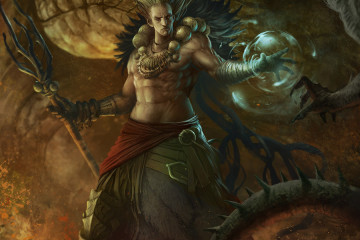
in which we behold the result of failing a contested roll with one’s wardrobe. Artwork by – Saryth
Having gone through the rest of rolling mechanics, we dive into roll modification. The game refers to this as advantage and disadvantage. Various feats, Banes, or Boons can grant advantage or disadvantage, as well as the GM imposing them at the level they feel is appropriate for what is occurring. The game includes a table of scenarios in which to give advantage or disadvantage based on roleplaying, and while it’s not totally consistent at least the game is giving examples of how to bring roleplay into combat and social interaction dice rolling mechanics.
Advantages and disadvantages have tiers of strength, and are always followed by a number indicating how much you’re getting, such as “Advantage 1” or “Disadvantage 3”. When you have sources of advantage and disadvantage both involved in the same role you do the math subtracting disadvantage from advantage; e.g. if I have advantage 3 and disadvantage 1 you would end up rolling with advantage 2.
For each advantage you have, you add that many dice of the attribute level you are to your roll, and keep the highest as appropriate to your attribute level. So if you have an attribute 5 and advantage 1 instead of rolling 2d6, you’d roll 3d6 keep the highest two. Similarly if you were attribute 4 and advantage 2 instead of rolling 1d10 you’d roll 3d10 and keep the highest. These advantage dice can of course explode, so advantage, especially for smaller size dice becomes less a chance of explosion and more of a controlled demolition.
Disadvantage, conversely, still requires you to add the dice to your roll, but you must drop the highest dice equal to the number of the disadvantage. If you were attribute 3 and disadvantage 2, you’d roll 1d8 as normal plus 2d8 disadvantage and toss the two highest dice keeping the lowest 1 for your result. This is the same as making you keep the lowest scoring dice as appropriate to your attribute level, so I’m not sure why they didn’t just phrase it that way*.
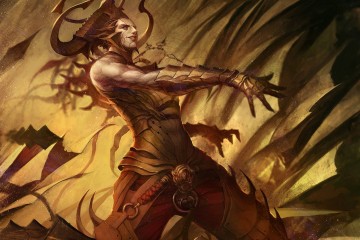
he smiled as he stared the terrified tailor in the face. “What are you worried about? You have a 3.25% chance of measuring me for a belt without getting stabbed” – Artwork by: Saryth
Following that is a short table showing the calculated odds of challenge rating versus attribute score to succeed about 50% of the time. The math here almost works out but characters sort of undulate between being under and over the idealized 50% success depending on their attribute level. At attribute 0 you’ve got a slight edge to beat a 0 challenge rating 50% of the time and at level 9 you’re slightly under your chance to succeed. Credit here due to NGDBSS
This chart of course is built ignoring the exploding dice. It's not a particularly egregious busted difficulty curve unless I misread the charts I got provided pretty badly, and for the record at attribute 0 you have an approximately 3.25% chance to beat a given level 9 challenge. Not that the game mentions this as an option, but worrying over exploding dice is also fully a moot point if your GM decides that attempting rolls above your level invokes disadvantage.
*I’m blaming THAC0. You can choose your own reason.
Up Next: Feats! And Wealth & Equipment! (Get two for one on this update because the Feats section is basically just a place holder page so you can find the feat list whenever you need it!)
Feats
Original SA post
Open Legend is available for free on https://openlegendrpg.com It contains art, tips, links to adventures, a blog, the full rules of course, and other details that this review won’t touch, so please visit the page if you’ve any interest.
Feats:
This section is less a section and more a recap of how feats work and a permanent hyperlink to the list of feats. Beyond this section of the rulebook webpages, there is an entirely separate section of the site navigation which directly takes you to the list of feats so you should never be particularly far from this page. In general, hyperlinking important reference material can’t be done enough so kudos.
The feats are otherwise the exact same as we left them, and the list has little tab out buttons if you want to save specific feats to view later in your browser. The only negative I have about that feature is that it doesn’t automatically create a new tab. The entire list of Feats proper is too long to list here and overall too dull to cover as many are just moderately altered DnD 3/5th feats. The entire list is presented sensibly in alphabetical order except for the feat “Master Tracker” which is located in the R section*.
Before we wrap up the feat section for the second time, I would like to point out something that came up as I got further into this book. Open Legend presumes that you use some sort of grid for combat, despite not mentioning anything about that until in the 7th of 8 sections, and that characters move over this grid at the rate of their move speed. Nowhere in the rules proper does it ever tell you what your move speed is or how you derive your score. The only place I could backsolve for what the game assumes your default movement is the feat “Insubstantial” which despite several other feats saying they modify your move distance is the only one to clarify exactly what a standard distance is.
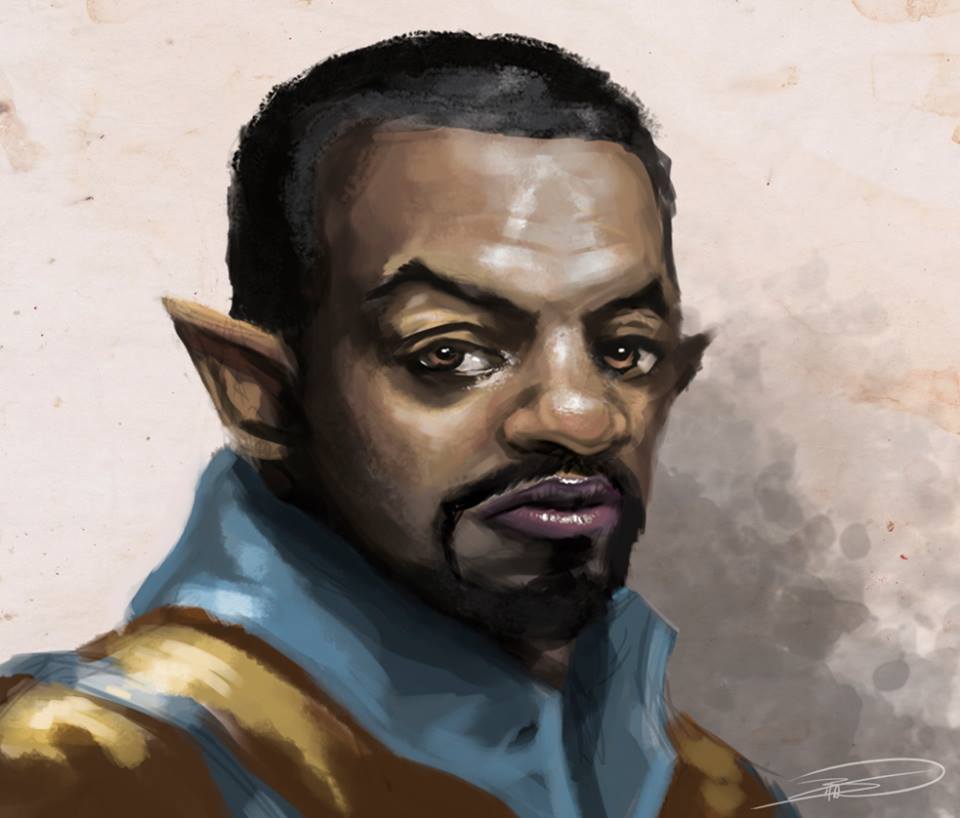
the face of a player realizing that buried in the feat list is the standard move speed - Artwork by: Vorpal Pen
Wealth and Equipment:
The section begins by telling us that no story of heroic deeds is complete without equally heroic gear and then throws out some examples of heroic gear to set the stage for the sort of iconic gear you’ll want to give your character. I would not have picked Bilbo and his Mithril shirt over say, Bilbo and his magic weapon with name that is repeated in hushed frightened tones by his enemies, but they needed a heroic piece of armor to round out their examples and didn’t have to suffer through the Aeneid in high school. Lucky Open Legend designers.
We immediately segue, then, into Wealth and purchasing items. While the game seems to think this is a natural transition point, literally all the items in the heroic examples the book gave were looted by or given free of charge to the heroes who wielded them.
Wealth in Open Legend is tracked using a 20th attribute called Wealth to determine well, your character’s wealth. Like other attributes this score ranges from 0-9, but unlike other attributes it can’t be raised except by GM fiat or feats, and starts the game at level 2. To try and avoid players being forever poor due to the GM, a table is provided with notes stating at certain levels characters should expect to be at minimum this level of wealthy. Also present on the chart is the belief that a literal “Street Urchin” can afford both three square meals a day and a warm bed at night.
Purchasing items in Open Legend is relatively simple. If the item is below your wealth score by any amount, you are presumed to be able to purchase as many as your heart desires as often as you want. If the item is of your level you may make the purchase, but you’ll take two-weeks to recuperate the wealth necessary to make another such purchase. You may also purchase an item from the tier one above your current wealth level, but after completing this purchase your wealth stat falls permanently by one point. Of further note, the GM is told they don’t have to sell you every piece of non-equipment goods you can theoretically buy at your wealth level, such as the listed at wealth level 8 army of 10,000 soldiers, with roleplaying excuses such as you not being worth dying for or capable of training and managing that many.
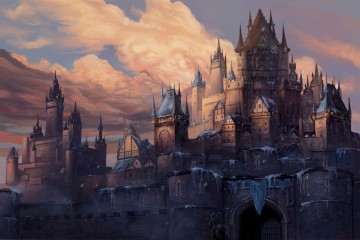
and all this can be yours, if The Price Is Right – Artwork by: Najarian
Now that we know how much we can buy, how much can we actually take home? This is where carrying capacity comes in. Every character, regardless of attributes, can carry a maximum of 20 items. Of those twenty items, characters may carry as many items tagged as “heavy” as their might attribute score + 1**. Lastly you may carry one item tagged as “bulky” as part of the 20 items, or if you’re willing to have your move speed reduced to 5’ you can carry a maximum of two “bulky” items. Open Legend does note that only interesting gear should count towards your twenty. So armor and weapons and a magic potion are part of the twenty, but your house keys and underwear aren’t. All in all, I'm fond of this section, even if the "bulky" rules seem unnecessary.
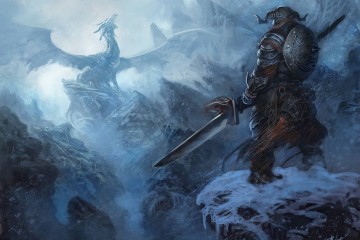
get over here so I can kill you, you stupid dragon – Artwork by: Dleoblack
Finally, the game is ready to get into the actual gear. Gear is split into Weapons, Armor, and… Gear. Weapons and Armor are defined by adjective tags given to them. It’s important to note that all weapons deal the same amount of damage, not that we know that yet, so the only differences between weapons are the tags they have associated with them and the Banes one can invoke using them. Conversely, each piece of armor has a strictly defined defense bonuses it grants you, with this bonus raising both your physical resistances but doing nothing to protect you from magic. Gear is purely tedious DnD inspired adventuring gear roleplaying items with no mechanical benefit, and all the examples have the “bulky” tag. If these Gear bundles weren’t in the rule book in this way I’d assume they’d fall under the items Open Legend would consider uninteresting and thus not part of your 20 item weight limit, so the game undermines its own elegance somewhat here.
Two particular things I’d like to note about gear in Open Legend. First, as a minor annoyance, the terms for the type of damage weapons do isn’t the same as the attribute they’re reliant on. Weapons with the “Forceful” tag rely on the might attribute, and weapons labeled “Precise” use agility. Why not just call them “Might” and “Agility” weapons?
Second, the only thing that determines how much armor you can wear is your fortitude attribute. You might remember that this attribute is also one of the three used to calculate your HP, and that armor’s defense bonus is applied to both of your physical resistances, including the one governed by agility. Even the most basic of armor grants enough defense to be worth effectively two levels in the agility attribute. With only 3 points invested in fortitude, a starting character can, without penalty, start with an effective 10-21 points in agility defense due to armor on top of the HP bonus they get that an agility character wouldn't recieve. You may be noticing, therefore, that taking agility as a main attribute is a bit of a sucker’s game.
*Feat prerequisite: Have found the "Master Tracker" feat.
**A wild derived stat appears
Up Next: Banes and Boons! (You know at this point, book, you should have just put the combat chapter next)
Banes and Boons
Original SA post
Open Legend is available for free on https://openlegendrpg.com It contains art, tips, links to adventures, a blog, the full rules of course, and other details that this review won’t touch, so please visit the page if you’ve any interest.
Banes and Boons:
Welcome to the part of the game Open Legend is most proud of, and possibly the heartbreakiest portion of the game. To quote Open Legend, “Banes and boons are a huge part of what makes Open Legend so open. They represent the endless possibilities of effects that your character can have on other characters beyond simply dealing damage.” and “Banes and boons are not tied to specific spells, attacks, or items. “ The second sentence is a lie according to a chart presented not 4 paragraphs ago, but we'll let that slide because the game seems to have forgotten as well.
Put it simply Banes and Boons are effectively a massive list of anything beyond a basic attack that any character, assuming they meet the things pre-requisite, can do. There is no memorizing Banes or Boons, no schools, no need to find them in the world, and no limitations on casting them as many times in a row as you please. Every character from the get go can theoretically be built to use any Bane or Boon on the list, although some attribute pre-requisites or scaled versions of the Banes or Boons will be impossible at level one. The game doesn’t make this quite clear here, but Banes and Boons are considered distinct categories in the rules as we’ll get to in a moment.
The game then takes a break to say that any benefit or negative applied by these skills should be roleplayed beyond what the text says. You don’t just grant your allies “resilience”, you cover them in your mystic aura of ice or a cloud of insects that follow you everywhere. I genuinely like this little pause since it says “fluff these however you want” which is one of those things I think people get way too wrapped up in these kind of TTRGPs.
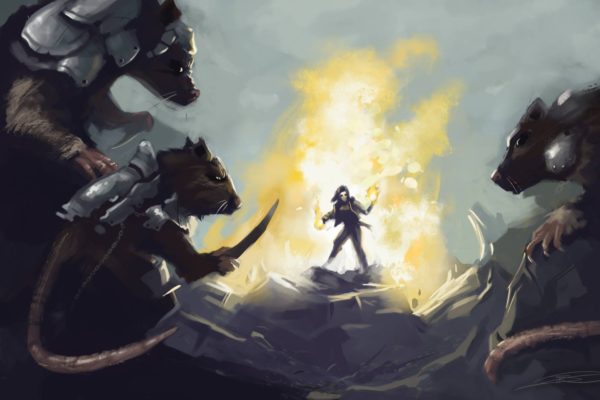
look at that adorable rat helmet. Artwork by – Vorpal Pen (Credited as Holy Avenging Vorpal Pen of Drawing +5 for this particular image)
Now that we know that we have these Banes and Boons, how the hell do we actually use these? It’s actually slightly different between Banes and Boons, but overall its fairly streamlined and intuititve. Both can only be done on your turn* in lieu of your standard attack. Banes however, in what I really like as a conceptual idea, can also proc as part of your main attack.
Boons are easy, characters simply need to pass a challenge rating task set at 10 + 2*Power Level of the Boon**. So if I want to invoke Haste at power level 2, I either use the Movement or Alteration attribute to beat a roll of 14. A completely untrained character has an approximately 40% chance of using a level 1 boon which is neat.
Banes are different and, as mentioned before, can be invoked in two ways. The first is similar to Boons and beat a target score, except in this case the target score is the enemies defense the Bane targets. For those of you doing the math at home, this is way easier than the Boon difficulty unless the GM just starts slapping piles of extra armor on enemies. The second is if you make an attack roll and beat the challenge rating by 10, you get a free Bane on top of your attack that uses the same attribute to invoke and has a maximum power level of the attribute score of the attack you made - 1. E.g. a Might 5 user hits someone, beats their defense by ten, and can then invoke a free might-based “Knockdown” Bane as the Bane is Power Level 2.
Lastly Open Legend explains how to read Bane and Boon descriptions. Each one consists of Name, Power Level, what attribute it checks against, the duration it lasts, a fluff description that is useless, and an effect description that is the actual mechanical effect. The game then provides links to these lists separately, and as with Feats there is also a completely separate page on the website to instantly hop to these lists.
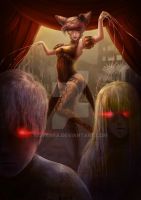
a literal puppet-master defense – Artwork by: Qyrara Art
With all the rules out of the way, I want to like the Bane and Boon system but it just doesn’t work right at all. There are a lot of issues and the system runs headlong into all sorts of problems from the very word go. Let’s get started.
First, off the bat, this system is way too much to throw at a starting player. Banes and Boons are two more lists of abilities to look at in addition to the 19 attributes, starting gear, and feats players need to juggle to start this game. It sounds great to make everything there at the beginning, but it creates massive option paralysis and requires intense cross referencing from three large lists to see if you’ve built a character who even does what you’re hoping it will. It’s especially glaring since the list is only alphabetical, so a new player has to sort out Banes and Boons they can never hope to cast at the outset to find the ones they’ll actually be taking advantage of. Once you are playing, hope you like referencing two lists constantly of everything you could possibly be doing on any given turn.
Second, the system isn’t equally spread around at all. It’s obvious they basically ported most of the spells and effects they could think of, but they didn’t make more of them to cover all attributes. For a particularly glaring instance, Might and Agility which are the two weapon attack attributes have 0 boons between them. On the other hand, the various supernatural groups have tons of overlaps not only on the Boons page but also the Banes list.
Third, many of these are dull or have rules built into them to hinder their use for no good reason. The ability “Immobilize” for example can be used by 6 different attributes, but if you do it via the Might attribute you also at get inflicted with the Bane. On the boon side of things, Open Legend includes rules to animate creatures, but it notes animating them gives you no control over them so if you animate something dangerous it will just come to life attacking you.
Fourth and finally, mechanically the checks and outcomes aren’t balanced at all. It’s remotely fun at all to have to make a check for things like “I heal my ally.” Open Legend, if you’re already giving up a turn to heal one person, don’t make it worse by letting people whiff on that completely. I should also mention healing options in general are pathetically weak, with an average single cast of heal not surpassing the damage of a character’s missed attack roll until level 4. It gets worse with the difference between Banes and Boons hit chances, as Boons at level 9 have a challenge rating of 4-10 points higher than Banes so offensive odds of success are completely out of sync with your party-boosting options. By the way this comparison is derived by back solving from an example chart in the last section of the game.
So in summary, Banes and Boons are a heartbreaker solution to fixing spell lists that doesn't quite work right. A lot of the issues though, come down to not providing enough options and not having a separate system for automatically succeeding at some boons. Presumably you could house rule those issues, but then you'd end up with an even bigger list of stuff players have to sort through on any given roll which is the other end of the problem.
*The game hasn’t explained this concept yet, but I think you get the idea.
**Yes, the game has never mentioned this before because yes, the game is that out of order the description of Banes and Boons comes after how to use them.
Up Next: Combat! (or: Wait, I need what to play?)
Combat
Original SA post
Open Legend is available for free on https://openlegendrpg.com It contains art, tips, links to adventures, a blog, the full rules of course, and other details that this review won’t touch, so please visit the page if you’ve any interest.
I actually use up the very last piece of art in this update, which is a bummer.
Combat:
We now come to the penultimate webpage in Open Legend, Combat. This chapter is the most-rule dense and the most obvious one that this game is a heartbreaker. Almost every rule involving combat, which includes things like movement and healing, is in here. The resulting monster page therefore has a revolving cast of gameplay concepts it is introducing and explaining here for the very first time, including what to me are fundamentals such as what sorts of things the game expects you to have on hand to play.
In an interesting choice, the chapter begins with examples of when not to use the combat rules, suggesting that GM only invoke these rules for fights that would be both fun and important enough to merit a blow-by-blow resolution. For examples, we’re told a mundane tavern brawl can probably be resolved with a single roll, while dueling a necromancer and his skeleton horde in our intertwined airships as they blast into each other is something we should be fighting out. We’re then given an overview of how combat is broken down, which follows the bog standard DnDism of rounds consisting of characters turns, six seconds per turn, and everyone having a turn in which to go during a given round but semi-randomly distributed based on their attributes.
With that, we kick off with initiative and surprise. Surprise is determined by your GM, who may or may not grant the party the opportunity to make checks to avoid the ambush, and yes the rules are that wishy-washy. Characters who are surprised in combat go last in the first round regardless of their initiative, may not interrupt any attacks made that first round, and all attacks against them have an advantage 1 bonus. Initiative, as the game then explains, is a score to determine what order characters take their turn in a round. Initiative is an agility roll (d20+ agility attribute dice) with straight highest to lowest ranking. Of a possibly interesting note, since I don’t remember DnD ever offering this, if you switch weapons during combat you may re-roll your initiative for the new weapon.
Before it gets into the full meat of battle, the game notes that in a combat encounter there will be quite a lot of rolling attacks, which might overwhelm a GM to come up with roleplay outcomes for all of them. The game encourages using a slight modification of its typical resolution mechanic instead, where on a failed combat roll the player in question and the GM choose from a short list of results to determine the outcome. Each chooses one outcome from the following list to inflict on each other: Deal 5 damage, inflict one bane of power level <= 3, a free bonus movement of 10’ without triggering opportunity attacks. It’s an elegant way to handle misses, but it doesn’t seem the most well balanced. It’s also not clear if the GM and the player can both pick the same one from the list, but the game is extremely clear this only applies to player rolls. If the GM whiffs, the GM whiffs.
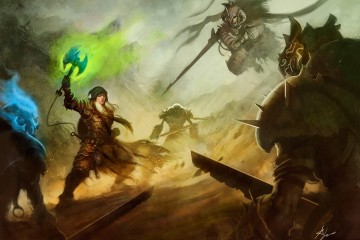
this is actually the art for an article on using politics to spice up your game’s story – Artwork by: Dleoblack
Open Legend then segues into what attributes can be used for making combat related rolls. Not every attribute can be used, and some are considered situational and up to the GM. Might for instance, is always available to fight with, logic is conditional such as in situations involving traps, and fortitude probably never will be unless the game notes there is a great reason given. This section seems a little pointless as Banes and Boons already state what attributes they use, weapons have defined attributes they function off of, there are feats that bypass/do the same thing as this, and this section is a loooong time after we chose what attributes our characters were going to use.
With the basics of combat resolution and rolling out of the way, Open Legend introduces the turn and what players can do on it. A turn consists of either a single focused action or a combination package of 1 move, 1 major, and infinite minor actions. Open Legend is not afraid of nested hierarchies, and there are three types of focus actions, five types of major actions, and 3 types of move actions all then summarily defined in helpful detail.
Focus Actions: on a successful bane inflicting attack remove all your opponents buffs, make a major action with advantage 1, or move twice your move speed and attack in melee range with disadvantage 1.
Major Actions: attack, invoke a bane, invoke a boon, assist an ally by forgoing your action to give them advantage 1, and take another move action.
Move Actions are: move your speed, make a non-standard movement such as climbing*, and attempt to remove a Bane currently afflicting you.
Open Legend then provides a 4-step chart that shows how to calculate all attack possible attack rolls in the game using the Standard Excel Pivot Table Color Scheme™. This chart tracks the type of attack, the distances involved, how each type of attack handles multiple targets, what attacks target what defenses, and for the first time in Open Legend how damage is calculated as well as when to proc a Bane. The chart sounds daunting when writing up what it covers, but is very streamlined and concise and the information it provides small enough that players should grasp their attacks with ease. Some small nerfs to non-magic users crop up in this chart with, ranged attacks made within melee range of an enemy having disadvantage unless you are using a magical ranged attack against the foe next to you.
The most interesting thing here is all magical attacks are ranged, but the distance of the attack is determined by your attribute score in that specific magic stat. So while one may have a 4 in energy and able to attack/use those abilities at 50 feet, doing the same with a creation 2 the effects can only travel 25 feet. Further, all magic actions can be made area of effect without requiring any special ability or specific bane or boon. Instead, for each additional increase in area size from single target 5x5 square, the roll takes another disadvantage, scaling up to a nigh-hopeless15 disadvantage at maximum to create a 75x75 foot square of effect.
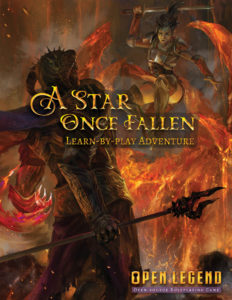
I’m completely out of art now, so next update I’m going to have to steal from a friend. In the meantime, here is the cover for the first module. – Artwork by: Uncredited(?)
We now detour back into actions for a moment to discuss minor actions. These include, but are not limited to as the game notes, drawing weapons, sustaining a boon, making mental checks to determine what you know about things, and making an opportunity attack. While you can take an infinite number of minor actions, you can only take one minor action per turn once so no pulling out weapons until you get the initiative score you want. As part of Minor Actions, characters may make opportunity attacks. Any enemy who was in your reach who is moved for any reason out of your reach gets a thwacking. Since it is a minor action, you can only perform it once a turn but combat in Open Legend is pretty lethal as is and opportunity attacks can inflict banes if you deal enough damage so it can be incredibly nasty.
The final action you can take, Interrupt actions which were never mentioned previously, are then introduced. This is basically a catch-all category for “I do [x] on reaction to help myself/ an ally” with examples given of say catching an ally pushed off a cliff. Doing an interrupt uses your next major action, but you can still move and make minor actions on your next turn. The game stresses that interrupts are intended only for helping fellow players, not alpha striking enemies by having the party take 8 turns of advantage boosted attacks in a row.
Open Legend then wraps up with how healing and reaching 0 hit points works. Characters reduced to 0 no longer take actions although they technically remain on the initiative order. Characters can never fall below 0, so any healing that hits them while at 0 has them instantly stand up at that number and resume at their place in the initiative order. After combat everyone still standing is restored to full health within 10 minutes, no spells, items, food, or anything required. Characters who were at 0 at the end of combat don’t get fully healed after 10 minutes, but do regain all their health after 2d4 hours. Not quite sure why that isn’t just a hard number as well. Of note regarding getting knocked to 0 hit points: if players are attacked while at 0 hit points, they must make a fortitude roll with the challenge rating set to half the damage they took. While it should be fairly rare this would ever come up or the characters fail since they still get full defense scores, it is incredibly cruel that you die permanently if you fail this roll.
This chapter draws to a final close, however, with a terrible, but thankfully optional, rule that seemingly exists to make the players suffer. On any d20 explosion, the die rolled after the exploding die is dealt immediately as special damage which cannot be healed by magic or by finishing the encounter. This hit point penalty is recovered at a rate of fortitude attribute per day, which turns a fun and relatively quick encounter game into a slog where enemies have a 5% chance of maiming the PCs for an average amount of 18%-100% of their health that even should the PC survive the hit will linger for long periods of time.
Of critical note is that nowhere in this section is any explanation of the unspoken assumption that you are playing on a grid with tokens, with each square on the grid measuring 5x5 feet. Further, the game never mentions how to track the oodles of status effects it’s rife with or, egregiously, if line of sight is even a concept. Combine this with having to dig around to figure out exactly how far you move and you've a recipe for combat that can't actually get started based on what's written in the rules.
*Uniquely to me all of these difficult movement checks rely on a characters might attribute, not agility. Agility is, as ever, a dump stat in Open Legends.
Up Next: Running the Game! (It’s pretty much what it says on the tin)
Running the Game
Original SA post
Open Legend is available for free on https://openlegendrpg.com It contains art, tips, links to adventures, a blog, the full rules of course, and other details that this review won’t touch, so please visit the page if you’ve any interest.
I’m now out of art, so please enjoy these 100% unrelated doodles from Minutae.
Running the Game:
We now reach the final chapter/webpage of Open Legend which is a grab bag of tips, design notes, general GM information, and the other snouts and tails needed to make a roleplaying session sausage. Keeping in the Heartbreaker tradition, this section is intended to be only read by the GM, but it contains shorthand charts and reference material and no concrete campaign details or enemy encounters so I can’t imagine why anyone should not read this section even if they never intend to GM.
We kick off with really good advice for what it means to be a GM and how to be a good GM. The game lays out and defines GM traits as the following. Telling a good story, not railroading players, knowing the rules and wanting to teach them to players as needed, not letting the rules get in the way of a good story or slow down the game, making sure the players are having fun, and designing the adventure to work for everyone. It gives suggestions for each, notes that the GM should always be building with players not against or inspite of them, and that the goal is to have fun for everyone. None of this is world-shattering stuff but it is great to have it written out*.
Open Legend then segues into how it suggest to go about building adventures. It recommends you have an idea of the Danger, the Motivation, and room for a Twist for any adventure. Danger is defined as what happens if the players do nothing, motivation is why they’re involved incase the Danger isn’t enough, and the Twist is either an escalation or enhancement of the adventure, not necessarily a “No, I am your father” moment. The game suggests not getting too worked into the fine details, and filling in bits only when players end up interacting with them.
We then jump to designing our hypothetical adventure to be either a Sequential or a Sandbox Adventure. Sequential adventures are single plots with a linear path through while Sandbox is multiple objectives where completing one is intended to impact the adventure that will transpire at the others. It then provides very brief sample adventures in both of these styles, pointing out the sort of groundwork you should have ready is just the highlights, when to take notes of player interest/actions, and how to avoid overwhelming yourself.
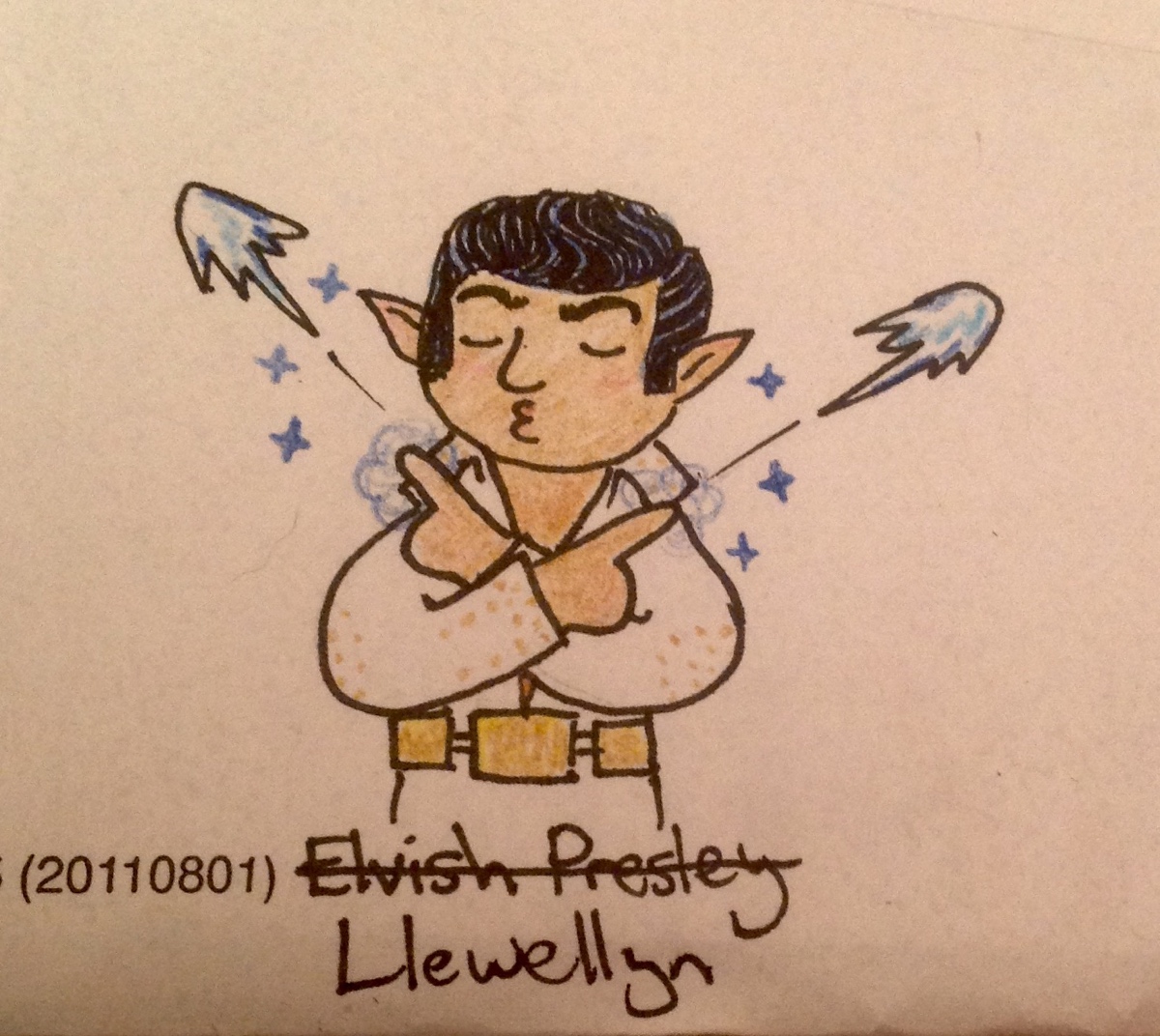
turns out copyright works across dimensions – Artwork by: Minutae
Campaign settings come next, and the game suggests that a campaign is really just a string of adventures that have some common bond, and there need not be some grand narrative tieing everything together if that’s not what the players at your table are after. For players who do want an overarching narrative to their adventures, the game recommends taking all the tools you used when building your Adventures and add another element, the Secret. This is suggested to be a detail of your setting that becomes an eventual hook for a full, world-shaking campaign. The game then gives a genuinely good sampling of ideas from the very basic “The questgiver is actually a Dragon” to the rather neat: “A world tree is the source of the planet’s life. When it dies, the world will not die, but instead be reborn in a new form. Every intelligent being is tied to an invisible spirit. A very few sinister mages, known as the Warlocks, have discovered how to see and bargain with these spirits in order to manipulate the world to their advantage.”
With our campaign and secret in hand, Open Legend suggests that you plan some rough elements of the world and some possible adventures, possibly tiering them into arcs so you know when to dispense more clues and information. In both examples, the game suggests the party should always feel like they are making progress and that you shouldn’t define too many of the details as partys are often want to wander off and miss all the things you planned so hard for. You’re then encouraged to get to like your setting by tooling around with what makes you like a setting, be it drawing maps, statting up monsters, or whatever it is that you like to do so that you also like the setting. Remember though, again, the party wanders off so be ready to re-purpose your work in this step.
Once the players are actually playing, you need to know how to reward them properly. The game re-iterates that it is wholly on the GM when they level, what they find, etc. so try to keep the rewards coming at a good pace and that fit narratively. Don’t keep your players poor and week forever, and as you expand the scope of the threat so should their strength. It then provides a rough sketch of character level as appropriate for what they’re fighting in a campaign with some examples. Alternately, Open Legend suggests you agree with players how many sessions equals a level up and go from there.
The wealth table then crops up again, copied verbatim, as examples of the sorts of rewards you can give players at different levels in the campaign even if their character isn’t necessarily that wealth level. In a rather pointed note, Open Legend reminds you that there is no point in picking every pocket, looting every corpse, and tracking every bauble. If players do want to find things, the game encourages you roleplaying small bits and bobs to add to their growing wealth score, and if players are gunning for specific things or need certain items to give them to them as appropriate amongst the otherwise meaningless treasure. Awkwardly shoved into this are mechanics for bribing people which follow the exact same rules for buying things so I’m not sure why this is here and not in the earlier wealth section.
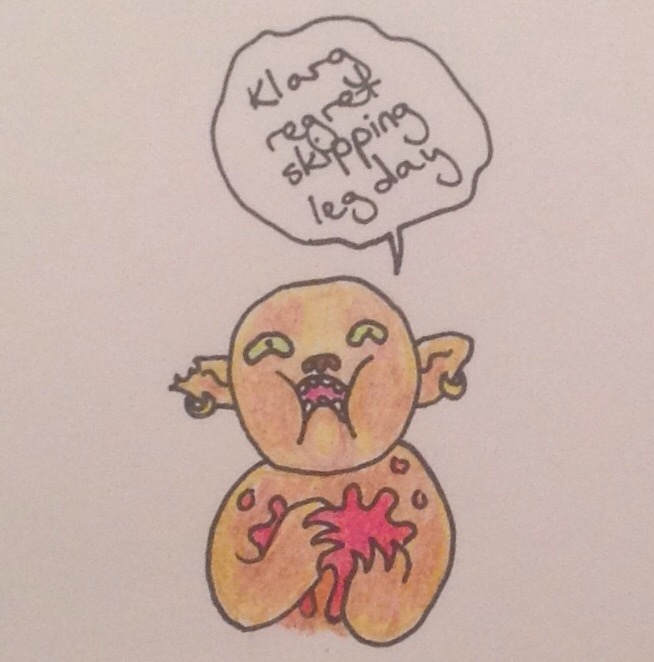
there are only banes for skipping leg day – Artwork by: Minutae
Now it is time to make some combat NPCs, which Open Legend bundles into Henchmen, Villains, and Allies. Henchmen are basically mooks, and the game encourages you not to sweat their motivation or stats too much as they are intended to be narratively expendable. Villains on the other hand, should be showpiece enemies who have motives, schemes, and one flaw so that players can understand what they’re up to and get a grasp of them as an opponent. Lastly, allies are npcs that provide support to the heroes. The game then bolds the following quote which is the first time it has used this formatting trick: ”Allies should empower the heroes, not outshine them.” It goes on to re-iterate that Allies should only in the most rare and extreme and probably never should anyway circumstances sweep in and save the day, deal the most damage in a fight, or create “but thou must” plot situations. If you do want to use NPCs in a battle, the game encourages you to make them support roles and reliant fully on the party to save the day.
In order to stat up our enemies, and Allies too I guess since the game doesn't mention doing this for them, Open Legend provides two methods for building these npcs. The first is the complex build, where you use the full character rules to build them and Open Legend actively recommends not doing this except for only the most important of NPC foes and to even then think twice. The second is the simple build, which is as easy as looking at a chart provided in the section which outlines the recommended HP, defenses, and attribute scores for a monster of that level or, on a separate chart, for boss monsters. Once these stats are copied over, the GM is given a list of unique, enemy-only abilities to tag the NPC with but no rules on how many to choose which rapidly becomes an issue.
Open Legend then tries to break down how to measure encounter difficulty. Functionally, your monsters may have a total number of levels equal to the total number of levels as your party. So for example, 4 players of 5th level characters should be fighting 20 levels of monster from the previous charts, and Open Legend values a boss as being worth 4 times their level when calculating monster levels. There is no level rating or modifier for the enemy abilities introduced earlier, and these abilities are not even remotely equivalent to each other. If your GM is a jerk, or hasn’t fully grasped the mechanical interactions of some of the abilities, this system is rife with wild swings between very lethal encounters or
With our foes now constructed and hopefully that right level of deadly, Open Legend encourages the GM to
To close out the entire manual, Open Legend ends with consequences for combat. It suggests letting the story continue regardless of the outcome of the fight, and giving the GM story suggestions for all sorts of end states of a battle. Open Legend then closes by saying that you shouldn’t strive to be balanced in an encounter but you should always be fair. Never surprise your players, but if things go south they go south and its up to you as the GM to resolve that in a way that the players are happy with and pushes the story forward. And with that bit of confusing advice, Open Legend unceremoniously ends.
*For John Wick to presumably ignore.
Up